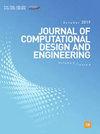使用卷积自动编码器进行船体形态转换的研究
IF 6.1
2区 工程技术
Q1 COMPUTER SCIENCE, INTERDISCIPLINARY APPLICATIONS
引用次数: 0
摘要
当代设计实践中的最佳船体形式主要包括三个部分:船体形式修改、性能预测和优化。船体形式修改是影响优化效率的关键步骤,因为要改变基线船体形式以寻求性能改进。传统的船体形状修改方法主要依赖于人为决策和干预。作为三维船体形式的直接表达方式,线条并不适合机器学习技术。这是因为,尽管数据维度相对较大,但它们并不能明确表达有意义的性能指标。为解决这一问题并开发一种基于机器的新型船体外形设计技术,本研究创建了一种自动编码器,这是一种基于人工神经网络的降维技术。具体来说,设计了一种卷积自动编码器;首先,使用卷积神经网络(CNN)预处理器有效地训练偏移量(即船体表面的半宽坐标值),以提取特征图。其次,堆叠编码器将特征图压缩成最佳的低维拉特向量。最后,转置卷积层恢复了线条的维度。在这项研究中,21 250 个船体形状被用作训练数据,它们分别属于集装箱船、液化天然气运输船和油轮这三种不同类型的船舶。为了更详细地描述船体形态,每个船体形态都被划分为若干区域,然后分别输入 CNN 预处理器。训练结束后,得到了一个由潜在向量分量组成的低维流形,以表示所考虑的三种船型的独特船体形态特征。然后,将自动编码器技术与代用模型的另一种新方法相结合,形成目标函数神经网络。进一步与确定性粒子群优化(DPSO)方法相结合,成功地实现了船体形状优化。总之,目前的卷积自动编码器已经证明了其在基于机器学习的船体设计过程中的重要性。本文章由计算机程序翻译,如有差异,请以英文原文为准。
A Study on Ship Hull Form Transformation Using Convolutional Autoencoder
The optimal ship hull form in contemporary design practice primarily consists of three parts: hull form modification, performance prediction, and optimization. Hull form modification is a crucial step to affect optimization efficiency because the baseline hull form is varied to search for performance improvements. The conventional hull form modification methods mainly rely on human decisions and intervention. As a direct expression of the 3-D hull form, the lines are not appropriate for machine learning techniques. This is because they do not explicitly express a meaningful performance metric despite their relatively large data dimension. To solve this problem and develop a novel machine-based hull form design technique, an autoencoder, which is a dimensional reduction technique based on an artificial neural network, was created in this study. Specifically, a convolutional autoencoder was designed; firstly, a convolutional neural network (CNN) preprocessor was used to effectively train the offsets, which are the half-width coordinate values on the hull surface, to extract feature maps. Secondly, the stacked encoder compressed the feature maps into an optimal lower-dimensional-latent vector. Finally, a transposed convolution layer restored the dimension of the lines. In this study, 21 250 hull forms belonging to three different ship types of containership, LNG carrier, and tanker, were used as training data. To describe the hull form in more detail, each was divided into several zones, which were then input into the CNN preprocessor separately. After the training, a low-dimensional manifold consisting of the components of the latent vector was derived to represent the distinctive hull form features of the three ship types considered. The autoencoder technique was then combined with another novel approach of the surrogate model to form an objective function neural network. Further combination with the deterministic particle swarm optimization (DPSO) method led to a successful hull form optimization example. In summary, the present convolutional autoencoder has demonstrated its significance within the machine learning-based design process for ship hull forms.
求助全文
通过发布文献求助,成功后即可免费获取论文全文。
去求助
来源期刊

Journal of Computational Design and Engineering
Computer Science-Human-Computer Interaction
CiteScore
7.70
自引率
20.40%
发文量
125
期刊介绍:
Journal of Computational Design and Engineering is an international journal that aims to provide academia and industry with a venue for rapid publication of research papers reporting innovative computational methods and applications to achieve a major breakthrough, practical improvements, and bold new research directions within a wide range of design and engineering:
• Theory and its progress in computational advancement for design and engineering
• Development of computational framework to support large scale design and engineering
• Interaction issues among human, designed artifacts, and systems
• Knowledge-intensive technologies for intelligent and sustainable systems
• Emerging technology and convergence of technology fields presented with convincing design examples
• Educational issues for academia, practitioners, and future generation
• Proposal on new research directions as well as survey and retrospectives on mature field.
 求助内容:
求助内容: 应助结果提醒方式:
应助结果提醒方式:


